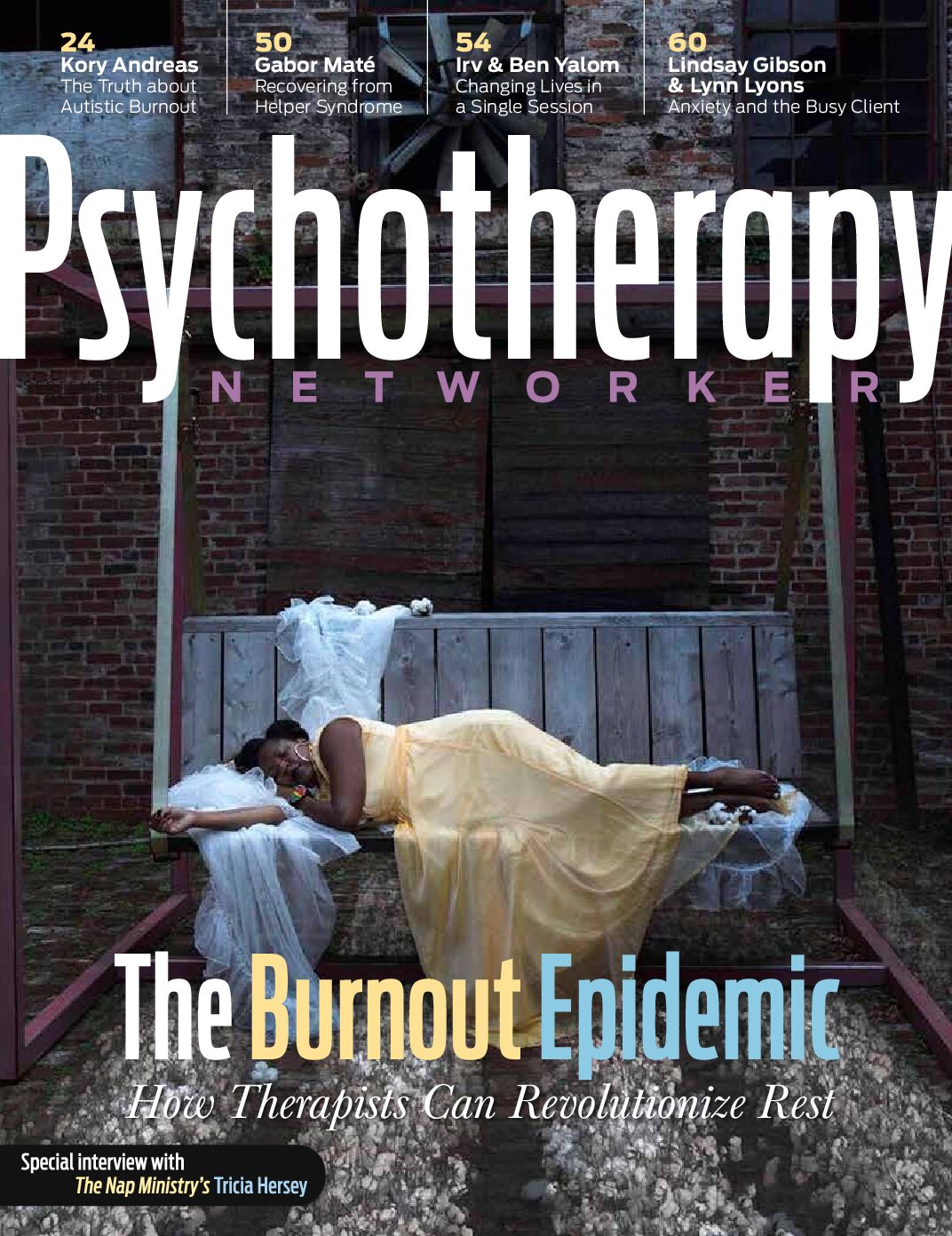In 1969, Elisabeth Kübler-Ross identified the five stages of dying in her groundbreaking book On Death and Dying. As a psychiatrist, she saw that patients who were dying appeared to go through common experiences or stages. Her work captured the world’s attention and would forever change the way we talk and think about death and dying. She ushered the truth of this universal experience out of shadowy euphemism and into the light.
Decades later, I was privileged to have been her protégé, friend, and coauthor of two books. In the second book we wrote together, On Grief and Grieving, which was her last, Elisabeth asked me to help adapt the stages she’d observed in the dying to account for the similar stages we’d observed in those who are grieving. The five stages of grief are denial (shock and disbelief that the loss has occurred), anger (that someone we love is no longer here), bargaining (all the what-ifs and regrets), depression (sadness from the loss), and acceptance (acknowledging the reality of the loss).
These stages were never intended to be prescriptive, and this holds true for both dying and grieving. They are not a method for tucking messy emotions into neat packages. They don’t prescribe: they describe. And they describe only a general process. Each person grieves in his or her own unique way. Nonetheless, the grieving process does tend to unfold in stages similar to what we described, and most people who have gone through it will recognize them. In the years since that book’s publication, I’ve experienced a great loss myself, and I can confirm that the five stages really do capture the feelings we experience as we grapple with the death of loved ones.
The fifth of Kübler-Ross’s five stages is acceptance. At this stage, we acknowledge the reality of the loss. We take some time to stop and breathe into the undeniable fact that our loved ones are gone. There’s nothing easy about this stage. It can be extremely painful, and acceptance doesn’t mean that we’re okay with the loss, or that the grieving process is now officially over. However, there’s been an assumed finality about this fifth stage that Elisabeth and I never intended. Over the years, I came to realize that there’s a crucial sixth stage to the healing process: meaning. This isn’t some arbitrary or mandatory step, but one that many people intuitively know to take and others will find helpful.
In this sixth stage, we acknowledge that although for most of us grief will lessen in intensity over time, it will never end. But if we allow ourselves to move fully into this crucial and profound sixth stage—meaning—it will allow us to transform grief into something else, something rich and fulfilling.
Through meaning, we can find more than pain. When a loved one dies, or when we experience any kind of serious loss—the end of a marriage, the closing of the company where we work, the destruction of our home in a natural disaster—we want more than the hard fact of that loss. We want to find meaning. Loss can wound and paralyze. It can hang over us for years. But finding meaning in loss empowers us to find a path forward. Meaning helps us make sense of grief.
When working with people whose loved ones have died, I often see how hard they search for meaning. It doesn’t matter whether the death occurred after a long debilitating illness, or if it came as a total shock after an accident or anything else that was sudden and unexpected. There’s often a desire to see meaning in it.
What does meaning look like? It can take many shapes, such as finding gratitude for the time they had with loved ones, or finding ways to commemorate and honor loved ones, or realizing the brevity and value of life and making that the springboard into some kind of major shift or change.
Those who are able to find meaning tend to have a much easier time grieving than those who don’t. They’re less likely to remain stuck in one of the five stages. For those who do get stuck, it can manifest in many different ways, including sudden weight gain (or loss), drug or alcohol addiction, unresolved anger, or an inability to form or commit to a new relationship out of fear of experiencing yet another loss. If they remain stuck in loss, then they may become consumed by it, making it the focus of their life to the point where they lose all other sense of purpose and direction. Although you can’t pin all your troubles or vices on getting stuck after a loss, there’s almost always a connection.
Grief is extremely powerful. It’s easy to get stuck in your pain and remain bitter, angry, or depressed. Grief grabs your heart and doesn’t seem to let go. But if you can manage to find meaning in even the most senseless loss, you can do more than get unstuck. When circumstances are at their worst, you can find your best. You can keep growing and finding ways to live a good and someday even a joyous life, one enriched by the lessons and love of the person who died.
The search for meaning after loss will lead each of us along divergent paths. Candy Lightner famously founded Mothers Against Drunk Driving (MADD) in 1980 after her daughter, Cari, was killed by a repeat drunk-driving offender. Even though she never understood why her daughter had to die, she was able to find great meaning in forming a group that saved the lives of others. For her, nothing was worth the cost of losing her daughter, but the ability to create something good from that death helped give her the sense that her daughter’s life as well as her own had meaning.
Of course, most of us are not going to act on such a large scale, but that’s not an obstacle to creating meaning. We can find meaning in the smallest of moments if we look for it and make a point of creating it.
Marcy grew up with a father whose favorite TV personalities were Milton Berle, Danny Thomas, and Morey Amsterdam. Because her father told her he’d met Danny Thomas once, a memory he cherished, after he died she thought of him anytime she saw or heard any reference to Danny Thomas.
One day she was in line at the post office to mail a package and buy some stamps. “What kind of stamps would you like?” the postal worker asked.
“Forever stamps.”
“We have flags and flowers and commemorative stamps. Do you want to see them?”
Who cares? Marcy thought. They all do the same thing. But she decided to look at what they had. Out came a vast array of stamps, and suddenly Marcy noticed one with Danny Thomas on it. Thinking of her father, she bought many sheets of those stamps. She didn’t frame them or do anything special with them. She just used them. Now, whenever she’s mailing a letter or paying a bill and she reaches for a stamp, she sees Danny Thomas and smiles. In those little moments, memories of her father’s life come back to her and bring her comfort. She doesn’t need anything more than a moment of sweet remembrance to find meaning in the life of her father.
In my work with grieving people, I’ve often been asked, “Where am I trying to find meaning? The death? The loss? The event? The life of the person I loved? Or am I trying to find meaning in my own life after the loss?”
My answer is yes, yes, yes, yes, and yes. You may find meaning in all of those, which will lead you to deeper questions and deeper answers. Maybe your meaning will come by finding rituals that commemorate your loved one’s life, or by offering some kind of contribution that will honor that person. Or the loss of your loved one may cause you to deepen your connection to those who are still with you, or to invite back into your life people from whom you’ve been estranged. Or it may give you a heightened sense of the beauty of the life we’re all so privileged to have as long as we remain on this earth.

Deirdre’s husband had died two years before the events she recounted to me, and she still missed him deeply. They’d had a very close, loving marriage, the loss of which left a large hole in her life. Her father had lost his brother the month before the death of Deirdre’s husband. She and her father had bonded in their grief. She said, “I knew his pain. He loved his brother. I got it.”
Deirdre and her family live in Hawaii, and on the day she later described to me they’d gathered at a campground near Pearl Harbor to watch her niece participate in a canoe race. A few minutes before the race was supposed to start, a nuclear warning siren pierced the morning air. Simultaneously, a text alert on Deirdre’s phone read Inbound missile alert. This is not a drill.
“A group of people came out from under a pavilion where the coaches were meeting,” Dierdre later told me. “They announced over the PA system, ‘Okay, everybody be safe, get home safely, and make sure everyone’s got a ride.’” She continued:
My dad, brother, uncle, and the rest of the family started breaking down their tents. I went to get my dad’s ropes from the car, and when I came back, everyone was gone, even my mom. My dad was the only one who hadn’t left yet. He didn’t seem to be in a hurry at all.
Why did everybody else just take off? Why didn’t they stay to say goodbye? It seemed ridiculous. If we were going to die, why not be together with those we loved when it happened? If there’d actually been an inbound missile, everyone would’ve died while they were in their cars racing home. No one said I love you or hope we see each other again. No one shared any final memories. We are a close family. Usually.
It was interesting to me that unlike everyone else, the two people who felt no need to run were my dad and me. We made a decision to be together in the time we had left. We had an amazing discussion during that terrifying period, and I thanked him for being my dad. He thanked me for being his daughter. We talked about what we loved most about life.
As a psychologist, I’ve tried to analyze why Dad and I stayed together for what we thought would be our last moments while everyone else in our family fled. I think it’s because the deaths of people we’d been so close to had taught us about how valuable life is. If we only had five or 10 minutes to live, we didn’t want to squander them.
It turned out to be a false alarm, but I love how Dad and I made a decision to spend what remained of our lives doing something meaningful. None of us know how long we have. Five minutes, five years, or 50 years. We don’t have that kind of control, but we do have control over how we choose to spend whatever time remains to us.
Ultimately, meaning comes through finding a way to sustain your love for the person after their death while you’re moving forward with your life. That doesn’t mean you’ll stop missing the one you loved, but it does mean that you’ll experience a heightened awareness of how precious life is, as Deirdre did. Whenever it ends—at a few days or in extreme old age—we rarely think that life is long enough. Therefore, we must try to value it every day and live it to the fullest. In that way, we do the best honor to those whose deaths we grieve.

All that said, nothing in either my personal or my professional life as a grief specialist had prepared me for the loss I experienced with the death of my 21-year-old son. This was a loss so shattering that despite all the years I’d spent helping others through their grief, I didn’t know if there was anything that could assist me through my own. And despite my awareness that the search for meaning is one of the keys to healing from grief, I didn’t know if there was any way I could find meaning in this loss. Like so many others who grieve, something in me felt that my grief was too great to be healed.
In 2000, I’d adopted two wonderful boys from the Los Angeles County foster care system. David was four years old and his brother, Richard, was five. By that time the two of them had been in five different foster homes and had one failed adoption. Addiction in their family background had hindered their permanent placement, as had the fact that David had been born with drugs in his system. When I heard that, I feared that it might mean something was wrong with him that wouldn’t be fixable. But it only took looking at the faces of those two little boys to tell me that love conquers all. The adoption went through, and in the years that followed, my belief in the power of love appeared to be confirmed. David and Richard both made an amazing turnaround and were wonderful kids.
Unfortunately, the trauma of David’s younger years came back to haunt him when he became a teenager. At around 17, David began experimenting with drugs. Luckily, he came to me not long afterward and told me he was addicted and needed help. In the next few years, our lives were filled with rehab and 12-step programs. By the time he was 20, however, he was sober, in love with a wonderful woman who was a recent social work graduate, and entering his first year in college. David had shown a real interest in following a career in medicine, and I felt hopeful. But then a few days after his 21st birthday, he made some typical relationship mistakes, and he and his girlfriend broke up. That was when he met up with a friend from rehab who was also having a tough time, and they used drugs again. The friend lived. David died.
I was across the country on a lecture tour when I received a call from Richard, sobbing that his brother was dead. In the months that followed, I was in an agony of grief. Fortunately, I was surrounded by friends and family who saw me not as a grief expert, but as a father who had to bury his son.
My friend Diane Gray, who headed the Elisabeth Kübler-Ross Foundation at the time and is a bereaved parent herself, told me, “I know you’re drowning. You’ll keep sinking for a while, but there will come a point when you’ll hit bottom. Then you’ll have a decision to make. Do you stay there or push off and start to rise again?”
What she said felt true. I knew in that moment that I was still in the deep end of the ocean, and I also knew that I was going to have to stay there for a while. I wasn’t ready to surface. But even then, I felt I would continue to live, not only for the sake of my surviving son but for my own sake as well. I refused to allow David’s death to be meaningless or to make my life meaningless. I had no idea what I would do to wrest meaning from this terrible time. For the moment, all I could do was to go through Kübler-Ross’s stages and allow them to unfold as slowly as I needed. Still, I knew I couldn’t and wouldn’t stop at acceptance. There had to be something more.
At first, I wasn’t able to find any consolation in memories of my love for my son. I had a lot of anger at that time—at the world, at God, and at David himself. But in order to go on, I knew I’d have to find meaning in the grief I was feeling. In my deep sorrow, I thought about a quote I share at my lectures: grief is optional in this lifetime. Yes, it’s true. You don’t have to experience grief, but you can only avoid it by avoiding love. Love and grief are inextricably intertwined.
As Erich Fromm says, “To spare oneself from grief at all costs can be achieved only at the price of total detachment, which excludes the ability to experience happiness.”
Love and grief come as a package deal. If you love, you will one day know sorrow. I realized I could have skipped the pain of losing David if I’d never known and loved him. What a loss that would have been. In the moment when I really began to understand that, I found gratitude for my son having come into my life and for all the years I got to spend with him. They weren’t nearly long enough, but they’d changed and enriched my life immeasurably. That was the beginning of my being able to see something meaningful in my grief.
As time goes by, I’ve been able to keep finding deeper meaning in David’s life as well as in his death. Meaning is the love I feel for my son. Meaning is the way I’ve chosen to bear witness to the gifts he gave me. Meaning is what I’ve tried to do to keep others from dying of the same thing that killed David. For all of us, meaning is a reflection of the love we have for those we’ve lost. Meaning is the sixth stage of grief, the stage where the healing often resides.
Finding Meaning
Here are some thoughts that may guide you in understanding meaning:
- Meaning is relative and personal.
- Meaning takes time. You may not find it until months or even years after loss.
- Meaning doesn’t require understanding. It’s not necessary to understand why someone died in order to find meaning.
- Even when you do find meaning, you won’t feel it was worth the cost of what you lost.
- Your loss is not a test, a lesson, something to handle, a gift, or a blessing. Loss is simply what happens to you in life. Meaning is what you make happen.
- Only you can find your own meaning.
- Meaningful connections will heal painful memories.
From Finding Meaning: The Sixth Stage of Grief by David Kessler. Copyright © 2019 by David Kessler. Reprinted by Permission of Scribner, an imprint of Simon & Schuster, Inc.
opening photo © i stock.antonio guillem; photo 1
© i stock .katarzynabialasiewicz
David Kessler
David Kessler, MA, RN, FACHE, is one of the world’s foremost experts on healing and loss. He’s the author of six bestselling books. His newest is Finding Meaning: The Sixth Stage of Grief. He coauthored two bestsellers with Elisabeth Kübler-Ross.













